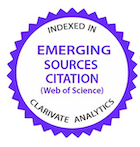Metodologia de colheita de células do trato respiratório em ovinos sadios através da técnica de lavagem traqueobrônquica por via nasotraqueal
Palavras-chave:
Sanidade Animal, ovinos, lavado traqueobrônquico, citologiaResumo
Avaliou-se a técnica de colheita de células do trato respiratório em ovinos, por sondagem nasotraqueal, e caracterizou-se a população celular em dezenove ovinos clinicamente sadios. Os animais foram contidos em estação, com cabeça e pescoço estendidos e alinhados com a coluna vertebral. Após a contenção, introduziu-se uma sonda-guia siliconizada até a bifurcação da traquéia, por dentro da qual se passou uma sonda de menor calibre, para realização do lavado traqueobrônquico. A média da contagem de células nucleadas foi de 64.650 ± 49.674. A análise citológica das amostras evidenciou, pelas médias das porcentagens obtidas, 62,74% de macrófagos, 15,01% de células epiteliais cilíndricas, 20,04% de neutrófilos, 1,44% de linfócitos e 0,77% de eosinófilos. Concluiu-se que o método de colheita por sondagem nasotraqueal foi eficiente na obtenção de amostras de regiões traqueobrônquicas para caracterização citológica e diferenciação celular nas amostras obtidas, sendo bem suportado pelos ovinos.
PALAVRAS-CHAVES: Citologia, citocentrífuga, lavado traqueobrônquico, ovinos
Downloads
Downloads
Publicado
Como Citar
Edição
Seção
Licença
Copyright (c) 2008 Ciência Animal Brasileira / Brazilian Animal Science

Este trabalho está licenciado sob uma licença Creative Commons Attribution 4.0 International License.
Autores que publicam nesta revista concordam com os seguintes termos:
- Autores mantém os direitos autorais e concedem à revista o direito de primeira publicação, com o trabalho simultaneamente licenciado sob a Licença Creative Commons Attribution que permite o compartilhamento do trabalho com reconhecimento da autoria e publicação inicial nesta revista.
- Autores têm autorização para assumir contratos adicionais separadamente, para distribuição não-exclusiva da versão do trabalho publicada nesta revista (ex.: publicar em repositório institucional ou como capítulo de livro), com reconhecimento de autoria e publicação inicial nesta revista.
- Autores têm permissão e são estimulados a publicar e distribuir seu trabalho online (ex.: em repositórios institucionais ou na sua página pessoal) a qualquer ponto antes ou durante o processo editorial, já que isso pode gerar alterações produtivas, bem como aumentar o impacto e a citação do trabalho publicado (Veja O Efeito do Acesso Livre).


























